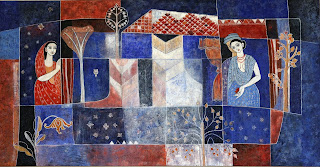How to Create Your First Painting
For a long time, people have considered painting to be something only the most professional of artists could carry out. But in truth, while you won't be able to see your painting for a million dollars, the concept of creating a painting is not a difficult task. If you follow the simple procedures of deciding your medium, your colours and a general idea of what it is you want to paint, you should be good to go. Let's take a look at how to create your first painting and what you need.
PALACE OF LOVE| Img via Sri Lanka Art GalleryDeciding Which Paint to Use
The most important part of painting is to consider your mediums. There are four main choices that you can make. These are pastels, watercolours, oils or acrylics.
Pastels are often the easiest medium to start painting with. Throughout colouring, you would come to choose your own brands depending on what preferences you obtain. Start with something inexpensive first and work your way up. Pastels can also be used at the start of a painting, rather like a sketch. There are some great brands in the market such as Rembrandt soft pastels, John Hersey's Unison handmade pastels and Schmincke.
Something quite traditional is watercolour paint which you would have used at some point in your life if you did art in school. The solubility and flow of watercolours make it both an easy and a hard medium to control. The best reason for the popularity of watercolours is how easily it can be cleaned and how the tubes are easily portable.
It is often the more experienced artists that use oils for their paintings. If you look at most traditional artists in Sri Lanka paintings will be done in a mixed medium of pencil sketches and oil paints. It creates a very beautiful effect. Oil paints are water-soluble, but the traditional way would require turpentine and a lot of effort in cleaning up.
This is why acrylic is considered a more viable and modern choice. They have been available for artists since the 1950s, they dry quickly, and they can be used across surfaces without the requirement of a primer.
Learning to Mix Colours
Beginners are often intimidated by mixing colours and prefer to stick to single shades. But if you think about it at the most basic levels, mixing colours is not very difficult and there is plenty of time to make mistakes and experiment. Try mixing colours with different mediums and work on a couple of paintings so you can navigate yourself around how each type of paint and the surfaces you use react.
The Steps in Making a Painting
The proper steps in creating a painting can vary from artist to artist. Some artists will begin with pencil sketches and others will start straight away with the paintbrush. Some prefer to fill in all the parts that require the same shade of colour while others would keep switching between brushes. Some use just one brush in a single size while others use multiple brushes in multiple sizes. The only way to find out which method is for you is to start painting.
Finding Ideas for Paintings
You can take inspiration from so many avenues when painting. You could go online and visit site the likes of Sri Lankan Art Gallery for painting inspiration. Or you could paint something in your daily life. Always be on the lookout for ideas and jot them down or create a Pinterest account to keep track of them. Good luck!




Comments
Post a Comment